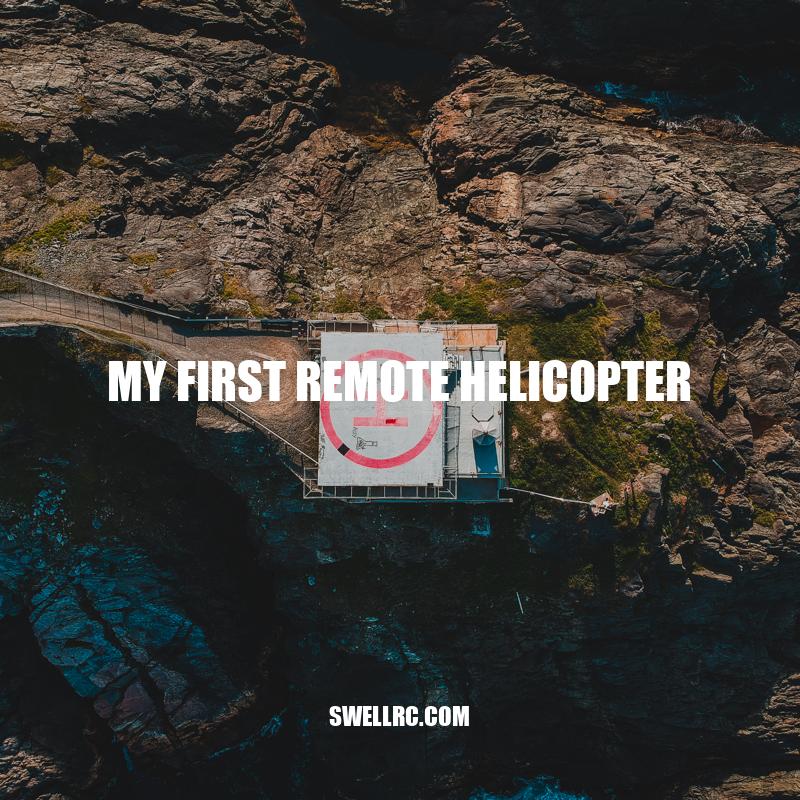My First Remote Helicopter: Tips and Tricks for Beginners.
Flying a remote-controlled helicopter for the first time can be an exhilarating experience. However, for beginners, it can also be a daunting task due to the complexity and technicalities involved. There are many different types of remote-controlled helicopters available in the market today, and each comes with unique features and levels of difficulty. If you are a beginner, choosing a suitable remote helicopter can significantly affect your experience. Getting the right type of helicopter that matches your skill level and budget can help you avoid frustration and accidents, and instead cultivate a sense of excitement and joy. In this article, we will provide you with valuable tips and tricks to help you choose your first remote helicopter wisely and help you have a smooth and safe flying experience. We will discuss the important factors you should consider before purchasing a helicopter, the different parts of a remote helicopter, and share essential flying tips and troubleshooting measures to help you fly your remote helicopter with ease.
When it comes to choosing my first remote helicopter, there are a few factors to consider to make the best decision. Here are some important features that beginner-friendly helicopters should have:
- Simplicity: Look for a helicopter that is easy to fly and operate, with basic controls that are easy to understand.
- Durability: As a beginner, it is inevitable that you will crash your helicopter a few times, so it is important to choose a sturdy and durable helicopter that can withstand the impact and last longer.
- Stability: A helicopter that is stable and easy to control can help you build confidence as you learn the basics of flying.
- Price: While you may be tempted to go for the most advanced and expensive helicopter, it is best to stick to a more affordable beginner-friendly option that meets your needs and budget.
Some recommended brands for novice flyers include Blade, Syma, and Estes, which offer a range of beginner-friendly options at reasonable prices. Online marketplaces such as Amazon and eBay also offer a wide selection of remote-controlled helicopters, with user reviews that can help you make an informed decision.
Once you have chosen your preferred helicopter, it is time to become familiar with its various parts and how they function. The following section will help you understand the essential components of a remote helicopter.
What is the best beginner remote helicopter?
The best beginner remote helicopter depends on the individual’s preferences, skill level and budget. However, there are a few models that consistently receive positive reviews, such as the Syma S107G, Blade Nano S2 and WLtoys V911. All three models are affordable, easy to control and provide a good starting point for beginners. It’s important to research and read reviews before purchasing any remote helicopter. Some websites that may be helpful include Amazon, Hobbytron and RC Geeks.
My First Remote Helicopter
If you’re interested in purchasing your first remote-controlled helicopter, it’s important to understand the components of the device. Knowing the parts can help you operate it more effectively and make necessary repairs when something goes wrong.
The transmitter is the device you hold to control the helicopter’s movement. It’s the device that sends signals to the receiver, which receives those signals and communicates with the helicopter’s motor. The motor then powers the rotors, the spinning blades that enable the helicopter to lift off the ground and remain stable in mid-air.
To make the motor and other components work, you will need a battery to provide electric power. The helicopter may also have a gyroscope, which helps the helicopter remain stable in-flight by sensing any changes in its orientation and adjusting the rotor speed accordingly.
To maintain and care for your remote-controlled helicopter, you must know its different parts and functions. Take some time to learn about your device and find some beginner tips. You can find plenty of user forums for remote helicopter enthusiasts, such as RC Groups and Helifreak. These sites offer product reviews and many other relevant resources that can help you get started.
What are the components of remote control helicopter?
The components of a remote control helicopter are:
- Motor
- Receiver
- Transmitter
- Battery
- Main rotor blades
- Tail rotor blades
- Gyroscopic stabilizer
Each component plays a vital role in the performance of the helicopter. For a comprehensive guide to remote control helicopter components and maintenance, RC Helicopter Fun is a useful website for beginners. For purchasing remote control helicopters and accessories, Hobbytron has a wide range of products to choose from.
Tips on Flying Your First Remote Helicopter
Flying a remote-controlled helicopter can be a thrilling but challenging experience, especially for beginners. Here are some tips to help you get started:
- Choose an open and spacious area to fly your helicopter, away from trees, buildings, or power lines.
- Start with basic movements such as hovering and simple forward and backward flight before attempting more complex maneuvers.
- Be patient and practice regularly to improve your skills and confidence.
- If you lose control of your helicopter while flying, reduce the throttle and try to land it safely instead of panic.
- Join online communities or groups such as RC Universe or RC Heli Addict to connect with other enthusiasts and get useful tips and advice.
By following these tips and gradually increasing the complexity of your flights, you will soon be able to fly your remote-controlled helicopter like a pro. Remember, flying a remote-controlled helicopter is a hobby that requires dedication and patience to master. With time and practice, you can enjoy the excitement and rewards of taking to the skies like a pro.
How hard is it to fly a remote control helicopter?
Flying a remote control helicopter can be challenging for beginners, but with practice, it can become easier. Here are some factors to consider:
- Size and weight: Smaller and lighter helicopters are generally easier to fly than larger and heavier ones.
- Number of channels: Helicopters with more channels require more skills to control, as they offer more control options.
- Experience: Experienced pilots find it easier to fly a remote control helicopter than beginners. They know how to deal with different flight conditions and can adjust accordingly.
- Weather conditions: Wind, rain, and other environmental factors can affect the flight of the helicopter, making it harder to control.
If you are a beginner and want to learn how to fly a remote control helicopter, there are websites and products available that can help you. One such website is rc-helicopter.org, which offers tips and tricks for flying remote control helicopters. Additionally, there are a number of remote control helicopters available for beginners that are designed to be easy to fly. The Syma S107G and Blade Nano helicopters are two popular options.
Troubleshooting Common Issues with Remote Helicopters
While flying a remote helicopter can be a fun and exciting hobby, mechanical issues can still arise during flight. Here are some common problems experienced by remote helicopter users and how to deal with them:
– Loss of Signal: If you lose control of your helicopter due to a weak signal or radio interference, try to move to a different location or change the channel on the controller to avoid interference. If all else fails, turn off the helicopter’s power to prevent it from flying out of range.
– Short Battery Life: Running out of power mid-flight can be frustrating and dangerous. To avoid this, always charge your helicopter’s batteries fully before flying, and consider investing in higher capacity batteries for longer flight times.
– Malfunctioning Motors: If your helicopter is not flying as smoothly as it used to, the motors may be malfunctioning. Inspect the motors and their gears for signs of damage, and replace parts as necessary.
– Crashed Helicopter: If your helicopter crashes and sustains damage, inspect it thoroughly before attempting to fly it again. Replace any broken parts before flying it again to avoid further damage or crashes.
In conclusion, troubleshooting common issues that arise with remote-controlled helicopters is essential. By staying vigilant and taking the necessary precautions, you can avoid accidents and enjoy your hobby to the fullest. Remember to seek advice from experienced flyer or online communities such as RotorCopters or RC Groups, if you are unsure how to handle any technical issues. With patience and practice, you can become a skilled remote helicopter flyer while also ensuring the safety of yourself and others.



